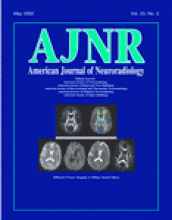Abstract
BACKGROUND AND PURPOSE: The long-term outcome of aneurysmal coil embolization has not been determined. We retrospectively analyzed the results of our cases treated with detachable coils and evaluated the long-term stability of embolized aneurysms.
METHODS: This study involved 100 aneurysms in 93 patients who underwent follow-up angiography ≥3 months after initial treatment between December 1993 and December 1999. The percentage of the coil volume occupying the aneurysm lumen (embolized volume) was used as an index to evaluate the stability of embolized aneurysms. The reliability of the embolized volume was also evaluated by comparing angiographic percentage occlusion.
RESULTS: Follow-up angiographic assessment was conducted 12 ± 8.5 months after initial treatment. Angiographic evaluation of percentage occlusion at initial treatment did not always predict long-term stability of embolized aneurysms. Of 49 aneurysms judged as being totally occluded at initial treatment, 44 remained unchanged and five showed recanalization. The embolized volume of unchanged aneurysms was 30.8 ± 10.2%, and that of recanalized aneurysms was 19.9 ± 10.6%. There was a significant difference between these two groups (P=.03). Of 29 subtotally occluded aneurysms, nine had further thrombosis (embolized volume = 31.8 ± 12.7%), nine remained unchanged (embolized volume = 23.2 ± 10.3%), and 11 had recanalization (embolized volume = 14.1 ± 6.1%). The mean embolized volume of 11 recanalized aneurysms was significantly lower than in the thrombosed group and the unchanged group (P=.002 and P < .001, respectively). Large aneurysms tended to have recanalization more frequently (59%) than did small aneurysms (15%).
CONCLUSION: There is a significant correlation between embolized volume and stability of embolized aneurysms. Embolized volume is a more objective index than is subjectively angiographic percentage occlusion. In addition to angiographic assessment, measurement of embolized volume could be useful to predict angiographic changes of aneurysms.
- Copyright © American Society of Neuroradiology












